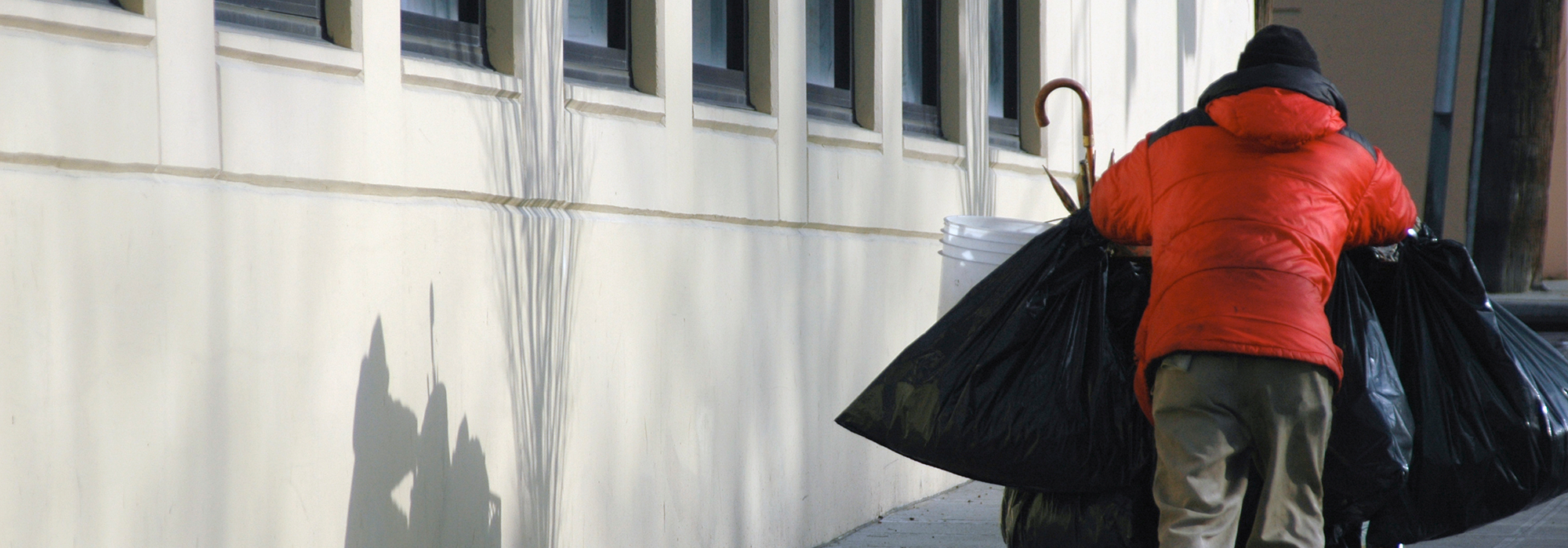Living on the streets means constantly being vulnerable – to the elements, to illness and hunger, and to the very group who should be there to protect you: law enforcement.
Far-reaching efforts to criminalize homelessness make the already-precarious state of being homeless and unsheltered even more dangerous. The criminalization of homelessness refers to policies, laws, and local ordinances that make it illegal, difficult, or impossible for unsheltered people to engage in the normal everyday activities that most people carry out on a daily basis, or in activities that help make them safer. These are known as life-sustaining activities, and criminalizing them makes it effectively illegal to be unsheltered, often without providing a sustainable alternative.
Behaviors that can be penalized under this system can include sleeping, resting, actively or passively requesting donations, jaywalking, and even simply existing in public (sometimes known as “loitering”). When their existence is considered a crime, people experiencing homelessness can be punished with expensive tickets and citations, “sweeps” which force them to evacuate the areas they’ve come to know as a home, and even arrest and incarceration.
Costly and Counterproductive
Criminalization policies give local law enforcement free rein to apply consequences, often arbitrarily, and sometimes violently. By bringing unsheltered people into frequent, unnecessary contact with law enforcement officials, criminalization invites avoidable dangers into their lives. Enforcing the criminalization of homelessness also unfairly drains taxpayer resources, with with some estimates appraising enforcement efforts (including the cost of incarceration) in an average mid-sized city at over $3 million annually, as seen in Colorado.
These efforts also make it harder for people to exit homelessness. Having a criminal record can make it harder to secure employment, housing, and other resources, and it makes a return to homelessness highly likely. In short, these policies may penalize homelessness, but they do nothing to reduce it.
Increased Risk of Violence
Unsheltered homeless people have a much higher than average rate of interaction with police officers. One recent analysis suggests that a person living outdoors was likely to encounter police more than twenty times in a single six-month period. The result of this, rather than improved conditions or returns to housing, is that people experiencing unsheltered homelessness are much more likely than others to become victims of police violence.
This has very implications when it comes to race. Black people make up forty percent of the homeless population, and about half of the unsheltered homeless population. Moreover, the data consistently indicates Black people are three times more likely than average to experience violence at the hands of police. This makes the link between unsheltered homelessness and police violence, and the need to undo criminalization, even clearer.
One of the most effective ways to immediately make life safer for unsheltered people, and to avoid the dangers listed above, is to dismantle the systemic criminalization of homelessness. Reducing the number of interactions between homeless people and police, reducing the number of local ordinances penalizing life-sustaining activities, and replacing criminalization tactics with housing and services can be the difference between life and death for many.
Take, for example, the case of Wayne Jones, a then-homeless man living in West Virginia who was shot 22 times by area police officers. Jones, who had previously been diagnosed with schizophrenia, was initially stopped by officers for jaywalking, an infraction frequently levied against people who live outdoors. He was soon enveloped in a “semicircle of five officers” who collectively opened fire on the man, leading to his death. Local ordinances empowering police officers to stop, harass, and punish citizens for normal activities are part of what led to what amounts to the public execution of an innocent person. Without these rules, Jones and many others like him may very well still be alive.
A Different Path Forward
For people who are homeless, especially those without shelter, replacing criminalization tactics with critical support can be life-saving. These changes can reduce the likelihood of unsheltered people coming into contact with law enforcement, restore a level of dignity not usually afforded to people without homes, reduce the length of time which some spends living outdoors, and protect a person from the harsh conditions of unsheltered living. The current cultural moment presents an opportunity to implement these changes nationally and locally, which the homelessness sector should seize vigorously and tenaciously.

